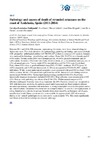Identificador persistente para citar o vincular este elemento:
https://accedacris.ulpgc.es/jspui/handle/10553/71339
| Título: | Pathology and causes of death of stranded cetaceans on the coast of Andalusia, Spain (2011-2014) | Autores/as: | Fernández Maldonado, Carolina Sierra Pulpillo, Eva María Arbelo, M. Diaz Delgado, Josue De La Fuente Marquez, Jesus Fernández Rodríguez, Antonio Jesús |
Clasificación UNESCO: | 310907 Patología 3109 Ciencias veterinarias |
Fecha de publicación: | 2016 | Resumen: | Between 2011 and 2014, 538 cetaceans, representing 16 species, were found stranded along the Andalusian coast. This study describes the epidemiology, pathological findings and causes of death (CD; grouped as ‘pathological entities’) of 104/538 (19%) stranded cetaceans (11 species). Samples were analyzed for histology, microbiology and virology. From 104, 59 (57%) were females and 45 (43%) males. Twenty seven (26%) were neonates/calves, 48 (46%) juveniles/subadults and 29 (28%) adults. Nineteen (18%) were very fresh, 54 (51%) fresh, 28 (27%) moderate autolysis, and 4 (4%) advanced autolysis. Twenty-eight (27%) stranded alive, and 76 (73%) were found dead. Thirty-three (32%) were in good nutritional status (NS), 17 (16%) moderate, 39 (37%) poor, 12 (12%) emaciated, and 3 (3%) not determined. A CD was recognized in 95/104 (91,34%) studied individuals. Within natural pathological categories, those associated with good NS involved 17/104 (16%); whereas 36/104 (35%) presented significant loss of NS. Interaction with fishing activities encompassed 19/104 (18%). Neonatal/perinatal pathology enrolled 8/104 (8%). Fatal intra- interspecific traumatic interactions included 9/104 (9%). Ship collisions were determined in 2/104 (2%). Foreign body pathology was observed in 2/104 (2%). Within natural categories CD, infectious pathogens (bacteria, virus, fungi) represent the 64%. Parasitic disease was recognized in 30% with fatal cases involving Toxoplasma gondii and Crassicauda sp. Fatal neoplastic disease included a pulmonary carcinoma with metastases in a long-finned pilot whale (Globicephala melas) and a hepatocelular carcinoma with metastases in a striped dolphin. A case of a fatal asphyxiation in a long-finned pilot whale due to primary bronchi obstruction caused by an European eel (Anguila anguila) is reported. Direct human activity is responsible for approximately 22% of cetaceans deaths, while ‘natural’ pathologies would account for approximately 78%. This study significantly contributes to baseline knowledge on cetacean pathology. | URI: | https://accedacris.ulpgc.es/handle/10553/71339 | Fuente: | 30th Annual Conference of the European Cetacean Society. Madeira, Portugal, 14-16 March 2016 / Luís Freitas; Cláudia Ribeiro (ed.), p. 231 |
| Colección: | Póster de congreso |
Visitas
37
actualizado el 10-ene-2026
Descargas
13
actualizado el 10-ene-2026
Google ScholarTM
Verifica
Comparte
Exporta metadatos
Los elementos en ULPGC accedaCRIS están protegidos por derechos de autor con todos los derechos reservados, a menos que se indique lo contrario.
